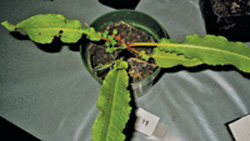
Features
Agronomy
Other Crops
Curled dock causing trouble in Red River Valley
Weed can lie dormant for decades and can cause a problem in wet years in Manitoba.
November 28, 2007 By Harry Siemens
 |
| Mature curled dock can be seen in ditches throughout the fall and winter. Photos Courtesy Of Bruce Murray, MAFRI. |
Manitoba's Red River Valley had two wet years in a row, 2004 and 2005. The
curled dock populations were up in 2006, but not as high as in 2005. Bruce Murray,
the provincial weed specialist for Manitoba Agriculture, Food and Rural Initiatives
at Carman, says there is a good reason for the populations of curled dock being
higher in 2005 than in 2006. This weed needs to take advantage of flooded conditions
to get going. Looking back to the 1997 flood in the Red River Valley, or the
widespread flooding in the southwest corner of Manitoba in 1999, or even the
very wet conditions throughout the province in 2005, producers were scratching
their heads wondering where this weed came from.
"It's out in the middle of the field and no one can remember seeing it
for quite awhile. Did it drift in, did it flow in, how did it get here?"
asks Murray.
While 80 years is an extreme number, 20, 30, 40 years is normal dormancy for
the weed. The weed uses this as a strategy, sitting dormant until it gets these
flooded conditions. It needs the wet conditions. Going back to 1997 or 1999
and again in 2005, when the weed became a problem, as the environment dried
out in 2006, the weed all but disappeared.
"That's not what it likes. It should disappear, go dormant and wait for
the next flood," says Murray. "Now, there are still curled dock seedlings
that will come, but to a much lesser degree. It's also perennial, so those plants
we'll have to take care of in-crop to get rid of them. I am very impressed by
the way producers got on top of this problem."
The provincial weed specialist says the name, curled dock, is quite descriptive
of what the perennial weed looks like. It has long, narrow leaves and the margins
or edges of the leaves are very curly and wavy. "Everyone should know it
driving around the province in the winter," he says. "They are those
weeds that are probably two to four feet high and a real dark brown colour,
standing in the ditches quite often, sticking above the snow."
Murray says producers are doing a good job controlling curled dock by using
their normal weed control methods in cereals, canola, and by using their regular
spraying program. There may be some misses where producers rely on contact herbicides.
Products like 2,4-D and MCPA will get its attention. Producers report good results
using products containing clopyralid like Lontrel, Spectrum and Curtail M.
 |
| Seedling curled dock can be recognized by its wavy leaves. |
"In those years where it really takes off, it's very competitive,"
he says. "It's like any weed, producers need to control it. If you control
it, you set your crop up to be competitive. If you don't, it's probably robbing
some yield."
Dr. Martin Entz, cropping systems and agronomy specialist at the Department
of Plant Science, University of Manitoba, agrees with Murray. "It's one
of those where the seeds last for decades," says Entz. "It likes wet
conditions. That's the main reason it has become a problem. It hasn't come from
somewhere else. It's always here."
Drying out the soil works to some extent. Fields with better drainage and fields
where farmers grow crops that use more water tend to have less curled dock.
It is highly competitive with other weeds in wet conditions. It will show up
in alfalfa fields, but typically only in low spots.
"When we have wet conditions, it rears its ugly head, and when we have
a series of dry years, it almost completely disappears and foxtail barley will
replace it," says Entz. "It's a weed that reflects soil moisture conditions."
Entz says the reason the weed stayed around in 2006 despite a hot dry summer
is the season started with a full profile of water, continuing where 2005 had
left off. Whether curled dock is back in 2007 depends on the weather, but producers
will be able to stay on top of the weed if they can properly identify it, and
then select the correct herbicide for in-season control.